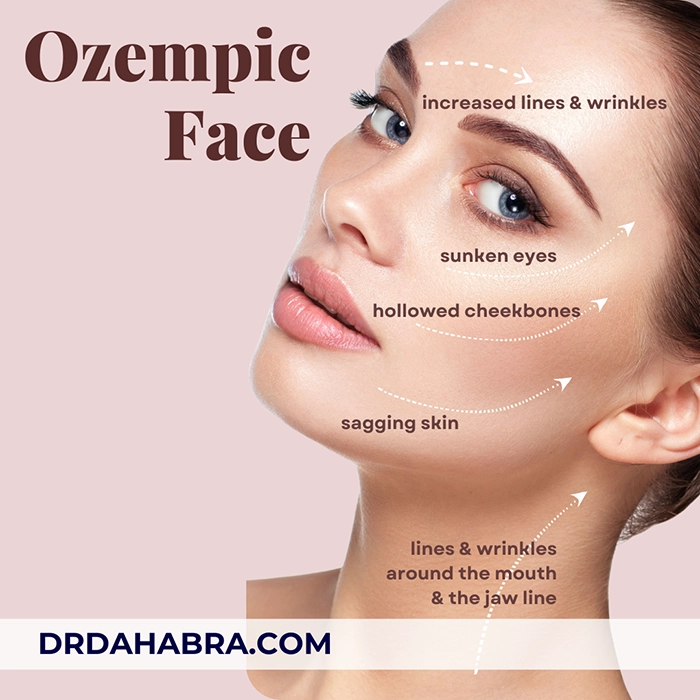The Ultimate Guide to Restoring Facial & Body Contours After Ozempic
Understanding Ozempic and Its Effects on Facial & Body Contours
Ozempic is a medication initially developed for managing type 2 diabetes but has gained widespread attention for its role in weight loss. This article is the ultimate guide to restoring facial and body contours after Ozempic.
Ozempic regulates blood sugar levels and reduces appetite, leading to significant fat loss over time.
However, rapid weight loss from Ozempic can cause unwanted side effects, particularly in the face and body. Many individuals experience volume loss in the cheeks, temples, and other areas, leading to a gaunt, aged appearance commonly known as “Ozempic face.”
The body may also suffer from sagging skin, particularly in areas where fat was previously stored.
While Ozempic provides life-changing benefits for those seeking weight loss, its impact on facial and body contours is a growing concern. Fortunately, various aesthetic treatments, including facial fillers, can help restore lost volume and rejuvenate the skin.
Table of Contents
1. What Is Ozempic Treatment with Fillers?
2. Common Concerns: What Does Ozempic Treatment with Fillers Address?
3. Why Ozempic Leads to Sagging Skin & Volume Loss
4. Minimally Invasive Solutions for Ozempic Face & Body
5. Types of Fillers Used for Ozempic Face & Body Restoration
6. Why a Professional Consultation Is a Key Before Getting Fillers
7. Treating the Ozempic Face with Dermal Fillers: What to Expect
8. Restoring Facial Volume After Ozempic with Dermal Fillers
9. Exploring Different Treatment Options for Ozempic Face
10. Treating the Ozempic Body with Dermal Fillers
11. Understanding the Side Effects of Ozempic Treatment with Fillers
12. The Cost of Ozempic & Related Aesthetic Treatments
13. Ozempic Dosage: What You Need to Know for Safe Use
14. Table: Factors Affecting the Cost of Ozempic Treatment with Fillers
15. Frequently Asked Questions (FAQs)
16. Conclusion
17. References
1. What Is Ozempic Treatment with Fillers?
Ozempic treatment with fillers is a cosmetic approach designed to counteract volume loss caused by rapid weight loss.
Dermal fillers, composed of substances like hyaluronic acid or calcium hydroxylapatite, are injected into areas that have lost fat to restore youthful plumpness.
This treatment is particularly effective for those suffering from Ozempic face, whose cheeks, under-eye area, and temples appear sunken due to fat depletion. It can also address sagging skin in the body by providing structural support.
By strategically injecting dermal fillers, medical professionals can recreate a fuller, smoother, and more youthful appearance without invasive surgery.
2. Common Concerns: What Does Ozempic Treatment with Fillers Address?
Individuals who experience drastic weight loss due to Ozempic often face multiple aesthetic challenges, including:
- Facial Hollowing: Loss of fat in the cheeks, temples, and jawline, leading to an aged appearance.
- Sagging Skin: The skin loses elasticity after fat depletion, causing loose, drooping skin on the face and body.
- Wrinkles and Fine Lines: The reduction in subcutaneous fat accentuates facial lines, making wrinkles more prominent.
Fillers can help restore lost volume, smooth out wrinkles, and provide a natural-looking lift.
3. Why Ozempic Leads to Sagging Skin & Volume Loss
The mechanism behind Ozempic-induced weight loss involves slowing digestion and suppressing appetite. As the body sheds fat, it does not discriminate between areas, leading to unintended volume loss in the face and body.
Unlike gradual weight loss, rapid weight loss does not give the skin enough time to contract, resulting in sagging. This is especially noticeable in individuals over 40, as collagen production declines with age.
Since Ozempic does not restore lost volume, additional cosmetic interventions like facial fillers become necessary for those seeking a balanced, youthful appearance.
4. Minimally Invasive Solutions for Ozempic Face & Body
For those looking to combat the effects of Ozempic without surgery, non-invasive and minimally invasive treatments offer practical solutions. Some of the best options include:
- Dermal Fillers: Instantly restore volume and improve facial contours.
- Skin Tightening Treatments: Procedures like Ultherapy and radiofrequency therapy help firm sagging skin.
- Collagen-Stimulating Injectables: Boost collagen production for a natural plumping effect.
These treatments require little to no downtime, making them ideal for individuals who want quick and effective results.
5. Types of Fillers Used for Ozempic Face & Body Restoration
Different fillers serve different purposes, depending on the severity of volume loss and the areas being treated.
- Hyaluronic Acid Fillers (e.g., Juvederm, Restylane): Best for restoring facial volume and hydration.
- Calcium Hydroxylapatite Fillers (e.g., Radiesse): Ideal for more profound volume loss and skin tightening.
- Poly-L-Lactic Acid Fillers (e.g., Sculptra): Work by stimulating collagen production for gradual improvement.
A professional consultation will determine which filler type best suits individual needs.
6. Why a Professional Consultation Is Key Before Getting Fillers
A professional consultation is essential to assess the extent of volume loss, determine the best filler type, and create a personalized treatment plan.
During the consultation, a board-certified provider will examine facial and body contours, discuss medical history, and outline realistic expectations. The goal is to ensure that results appear natural and complement the individual’s unique facial structure.
Choosing an experienced injector also reduces the risk of complications, ensuring safe and satisfactory outcomes.
7. Treating the Ozempic Face with Dermal Fillers: What to Expect
The process of treating Ozempic face with fillers involves the following:
- Consultation & Facial Analysis: Identifying areas of volume loss.
- Injection Process: Strategic placement of fillers to restore lost volume.
- Post-Treatment Care: Managing swelling and ensuring optimal results.
Most people notice immediate improvements, with full results appearing within two weeks.
8. Restoring Facial Volume After Ozempic with Dermal Fillers
Facial volume loss after Ozempic can significantly impact confidence. Fillers help by:
- Lifting sagging skin in the cheeks and jawline.
- Smoothing out wrinkles for a youthful appearance.
- Restoring facial proportions to maintain symmetry.
Results typically last between 6-18 months, depending on the type of filler used.
9. Exploring Different Treatment Options for Ozempic Face
Restoring lost facial volume after Ozempic-induced weight loss requires a personalized approach. While dermal fillers are popular, other treatments can complement and enhance results.
- Dermal Fillers: The go-to treatment for adding volume and smoothing out sagging skin.
- Collagen-Boosting Injections: Treatments like Sculptra work overtime to stimulate collagen production, providing a natural plumping effect.
- Fat Transfer: Involves using the patient’s fat from another area of the body to restore facial fullness. This option is longer-lasting than traditional fillers.
The best approach often involves a combination of treatments to achieve natural and balanced results. A professional consultation can help determine the right plan for individual needs.
10. Treating the Ozempic Body with Dermal Fillers
Just as Ozempic affects the face, it can also lead to volume loss in areas like the hands, buttocks, and arms. The sudden reduction in fat can leave skin looking loose and deflated, requiring strategic restoration treatments.
- Radiesse and Sculptra for Body: These fillers are commonly used to restore volume and improve skin texture on the buttocks and thighs.
- Hand Rejuvenation: Dermal fillers can add back lost volume, reducing the appearance of veins and wrinkles.
- Décolletage Restoration: Filler treatments in the chest area can help smooth out sagging skin and fine lines.
Dermal fillers for the body provide a non-surgical alternative to traditional fat grafting, offering a more youthful and toned appearance.
11. Understanding the Side Effects of Ozempic Treatment with Fillers
While fillers are a safe and effective treatment for Ozempic-induced volume loss, there are some potential side effects. These can vary depending on the type of filler used, the skill of the injector, and individual skin sensitivity.
- Common Side Effects: Mild swelling, bruising, and tenderness at the injection site. These typically subside within a few days.
- Less Common Risks: Lumps, asymmetry, or allergic reactions. Choosing an experienced injector minimizes these risks.
- Long-Term Considerations: Fillers naturally dissolve over time, but some types (like Sculptra) stimulate collagen production, offering longer-lasting results.
Proper aftercare and choosing a qualified provider can help ensure safe, effective, and natural-looking results.
12. The Cost of Ozempic & Related Aesthetic Treatments
The cost of Ozempic and the treatments required to restore facial and body volume afterward can vary significantly.
- Ozempic Cost: Ranges from $900 to $1,200 per month without insurance. Some insurance plans may cover it for diabetes treatment but not for weight loss.
- Dermal Filler Cost: Fillers range from $600 to $2,000 per syringe, depending on the type and amount needed. Most people need multiple syringes for full-face restoration.
- Combination Treatments: If additional treatments like collagen-boosting injections or laser therapy are used, costs can increase further.
Investing in a skilled provider ensures optimal results, reducing the need for frequent corrections or touch-ups.
13. Ozempic Dosage: What You Need to Know for Safe Use
Understanding Ozempic dosing is essential for achieving safe and effective weight loss results. The medication is typically prescribed in a step-up dosing schedule to minimize side effects.
- Starting Dose: 0.25 mg per week for the first four weeks to help the body adjust.
- Standard Maintenance Dose: 0.5 to 1 mg per week, depending on individual response and doctor recommendations.
- Maximum Dose: Some individuals may be prescribed up to 2 mg weekly for enhanced weight loss effects.
It’s essential to follow a doctor’s guidance and not exceed the recommended dose, as higher amounts can increase the risk of side effects such as nausea, fatigue, and gastrointestinal issues.
14. Table: Factors Affecting the Cost of Ozempic Treatment with Fillers
Factor Explanation Impact on Cost
Type of Filler Hyaluronic acid fillers cost less than collagen-stimulating fillers. Medium
Number of Syringes More volume loss requires more filler. High
Provider’s Expertise Experienced injectors charge higher fees. High
Treatment Area Treating both face and body increases cost. High
Location Clinics in major cities charge more. High
Clinic Reputation High-end clinics may charge premium fees. Medium
Filler Longevity Longer-lasting fillers may be more expensive. Medium
Additional Procedures Combining treatments increases cost. High
Consultation Fees Some providers charge separately for consultations. Low
Maintenance Sessions Periodic touch-ups add to the overall expense. Medium
15. Frequently Asked Questions (FAQs) About Restoring Facial and Body Contours After Ozempic
Q1. How do fillers help restore your face, “Ozempic Face”?
Concise Answer: Fillers add volume to areas of the face that lose fat due to Ozempic, restoring a fuller, more youthful appearance.
Detailed Answer: Ozempic face occurs when rapid weight loss causes a depletion of facial fat, leading to hollowed cheeks, sunken temples, and sagging skin. Dermal fillers, especially hyaluronic acid-based options like Juvederm and Restylane, work by replacing this lost volume.
These fillers plump the skin, smooth wrinkles, and enhance facial contours. Other options, like Sculptra, stimulate collagen production, offering gradual and long-lasting improvement.
When performed by an experienced injector, fillers create a natural-looking restoration, making the face appear healthier and more youthful.
Q2. Will Ozempic dissolve and metabolize the fat injections or dermal fillers in my face?
Concise Answer: Ozempic does not directly dissolve fillers, but weight loss can alter facial contours, making existing fillers appear different.
Detailed Answer: Unlike body fat, dermal fillers are composed of synthetic substances like hyaluronic acid or calcium hydroxylapatite, which are not metabolized in the same way as natural fat. However, because Ozempic leads to ongoing fat loss, it may change facial structure over time, affecting how fillers settle.
This is why some patients require touch-ups or additional filler sessions to maintain their desired look. Some fat may be reabsorbed if fat grafting is used instead of synthetic fillers, but this is a regular part of the fat transfer process.
Q3. Is it OK to get Botox while taking Ozempic?
Concise Answer: Botox and Ozempic can work together on different aspects of facial aging.
Detailed Answer: Botox targets dynamic wrinkles caused by muscle movement (such as frown lines and crow’s feet), whereas dermal fillers restore lost volume. Since Ozempic primarily affects fat loss and not muscle activity, there is no direct conflict between the two treatments.
Many patients undergoing facial rejuvenation after Ozempic-induced weight loss opt for Botox and fillers to achieve a balanced, youthful appearance. However, it’s always best to consult a professional to determine the right approach for your needs.
Q4. Is Ozempic an injection for weight loss?
Concise Answer: While initially developed for diabetes, Ozempic is now widely used for weight loss due to its appetite-suppressing effects.
Detailed Answer: Ozempic was first approved as a diabetes medication to help regulate blood sugar, but researchers quickly discovered its effectiveness in reducing body weight. It mimics a hormone called GLP-1, which slows digestion and decreases hunger.
As a result, many people experience significant weight loss while on Ozempic. A similar medication is FDA-approved for weight loss and contains the same active ingredient, but in higher doses.
Q5. Can Ozempic and Botox be used together?
Concise Answer: Combining Ozempic and Botox is safe and commonly used for facial rejuvenation.
Detailed Answer: Botox relaxes facial muscles to reduce wrinkles, while Ozempic influences weight loss by controlling appetite. Since they target different mechanisms, they can be used together without issues.
Many patients using Ozempic choose Botox to enhance their facial aesthetics, especially since weight loss can sometimes make wrinkles more noticeable. Always consult a medical professional to ensure Botox is injected in the correct areas for the best results.
Q6. What is the maximum dose of Ozempic for weight loss?
Concise Answer: The highest FDA-approved dose of Ozempic is 2 mg weekly.
Detailed Answer: Ozempic dosing starts at 0.25 mg per week to allow the body to adjust, then increases to 0.5 mg or 1 mg. The maximum approved dose for diabetes management is 2 mg per week.
Following your doctor’s guidance is essential, as higher doses may lead to more potent side effects like nausea and fatigue.
Q7. What are the side effects of Ozempic for females?
Concise Answer: Common side effects include nausea, fatigue, and digestive issues, while rare side effects may involve hormonal changes.
Detailed Answer: Women taking Ozempic may experience mild to moderate side effects such as nausea, vomiting, constipation, and fatigue. Some women also report changes in their menstrual cycle, likely due to rapid weight loss affecting hormone balance.
While most side effects improve over time, monitoring and discussing any persistent issues with a doctor is essential.
Q8. What is Ozempic used for?
Concise Answer: Ozempic is primarily used for managing type 2 diabetes but is also prescribed for weight loss.
Detailed Answer: Ozempic helps regulate blood sugar levels by increasing insulin production and slowing digestion. It also suppresses appetite, making it an effective tool for weight loss.
While only approved for diabetes, many doctors prescribe it off-label for patients looking to lose weight, as studies have shown significant results in reducing body fat.
Q9. Can Ozempic make you tired?
Concise Answer: Fatigue is a common side effect of Ozempic, especially in the early weeks of treatment.
Detailed Answer: Many patients report feeling unusually tired when starting Ozempic. This could be due to lower blood sugar levels, reduced calorie intake, or the body adjusting to hormonal changes.
If fatigue persists, it’s essential to check with a doctor to rule out any underlying issues, such as dehydration or nutrient deficiencies.
Q10. Can Ozempic cause depression?
Concise Answer: While rare, some people report mood changes while taking Ozempic.
Detailed Answer: There is no direct link between Ozempic and depression, but rapid weight loss and changes in blood sugar levels can sometimes affect mood. Some individuals may experience emotional fluctuations, especially if they have a history of depression or anxiety.
It’s essential to consult a healthcare provider if significant mood changes occur.
Q11. Can Ozempic be used for butt augmentation?
Concise Answer: Ozempic is not designed for body contouring and may cause buttock volume loss.
Detailed Answer: Since Ozempic leads to fat loss, it often results in a more minor, flatter appearance of the buttocks rather than enhancing them. If volume loss is a concern, dermal fillers like Sculptra or fat transfer procedures can be used to restore shape and fullness.
Q12. Is Ozempic safe?
Concise Answer: It should only be used under medical supervision due to potential side effects.
Detailed Answer: Ozempic is FDA-approved and generally safe for most people, but it does carry risks such as nausea, fatigue, and possible long-term effects on the pancreas. Always follow medical advice when using this medication.
Q13. Can Ozempic be used during pregnancy?
Concise Answer: No, Ozempic is not recommended for pregnant women.
Detailed Answer: There is limited data on Ozempic’s effects during pregnancy, but studies suggest potential risks to fetal development. Women trying to conceive should stop Ozempic at least two months before attempting pregnancy.
Q14. What are the dangers of taking Ozempic for weight loss?
Concise Answer: Potential risks include nausea, gallbladder issues, and loss of muscle mass.
Detailed Answer: While Ozempic is effective for weight loss, it can lead to side effects like gastrointestinal discomfort, excessive muscle loss, and potential long-term risks like pancreatitis. Monitoring side effects and adjusting dosage as needed under medical guidance is crucial.
Q15. Does Ozempic cause sagging skin?
Concise Answer: Rapid weight loss from Ozempic can lead to sagging skin, especially in the face and body.
Detailed Answer: When people lose weight quickly, their skin doesn’t always have time to adjust, leading to loose or sagging areas. This is especially common in individuals over 40, as collagen and elastin production naturally decline with age.
The face may appear more hollow (Ozempic face), while areas like the arms, stomach, and thighs may experience skin laxity. Treatments like dermal fillers, radiofrequency skin tightening, and collagen-boosting injectables can help restore firmness and volume.
Q16. How long does it take for Ozempic to show weight loss results?
Concise Answer: Most people start noticing weight loss within 4 to 8 weeks, with significant results in 3 to 6 months.
Detailed Answer: Weight loss with Ozempic varies from person to person, but many report losing a few pounds in the first month. Noticeable weight reduction often occurs by the three-month mark, especially when combined with healthy eating and exercise.
Full results can take six months to a year, depending on the starting weight, dosage, and lifestyle changes.
Q17. Will stopping Ozempic cause weight regain?
Concise Answer: Weight regain is standard after stopping Ozempic if lifestyle changes are not maintained.
Detailed Answer: Ozempic helps suppress appetite, so hunger levels may return to normal when the medication is discontinued. It’s easy to regain lost weight without consistent dietary habits and physical activity.
Some people switch to maintenance doses or alternative weight management strategies to sustain their results.
Q18. Can Ozempic affect my skin quality?
Concise Answer: Yes, rapid weight loss can lead to dryness, sagging, and an aged appearance.
Detailed Answer: While Ozempic doesn’t directly harm skin, its weight loss can lead to the loss of fat that previously supported the skin, making wrinkles more visible. Some people also experience dullness or dryness due to reduced nutrient absorption.
Hydration, collagen supplements, and skin treatments like microneedling or fillers can help improve skin quality.
Q19. Is Ozempic linked to hair loss?
Concise Answer: While not a direct side effect, some people experience hair thinning due to rapid weight loss.
Detailed Answer: Significant weight loss can sometimes trigger telogen effluvium, a temporary condition where hair shedding increases due to stress on the body. This happens because the body prioritizes vital functions over hair growth when nutrient levels shift.
Ensuring adequate protein, vitamins (especially biotin and iron), and overall balanced nutrition can help minimize hair loss.
Q20. How often do I need fillers after Ozempic weight loss?
Concise Answer: Most fillers last 6 to 18 months, so maintenance treatments are needed about once a year.
Detailed Answer: The frequency of filler touch-ups depends on the type of filler used, individual metabolism, and volume loss. Hyaluronic acid fillers like Juvederm typically last around 6 to 12 months, while collagen-stimulating fillers like Sculptra can last up to 2 years.
Adjustments may be needed to maintain balanced facial proportions if weight loss continues.
Q21. What’s the best treatment for the Ozempic face?
Concise Answer: Dermal fillers, Sculptra, and fat transfer are the best treatments for restoring facial volume.
Detailed Answer: The best treatment depends on the level of volume loss and personal preference. Hyaluronic acid fillers like Restylane offer immediate results, while Sculptra gradually stimulates collagen production for longer-lasting effects.
Fat grafting (where fat is taken from another part of the body and injected into the face) is another option for those who prefer natural restoration.
Q22. Does Ozempic affect muscle mass?
Concise Answer: Rapid weight loss can lead to muscle loss, especially without strength training.
Detailed Answer: Ozempic primarily targets fat loss, but muscle loss can also occur if calorie intake is too low. This can lead to a less toned appearance and decreased strength.
Consuming enough protein and regular resistance training is essential to prevent muscle loss.
Q23. Can men experience Ozempic face, or is it just women?
Concise Answer: Both men and women can develop an Ozempic face due to rapid fat loss.
Detailed Answer: While the Ozempic face is often discussed in women, men are equally affected by volume loss in the face. Since men tend to have thicker skin and different fat distribution, the effects may vary, but hollow cheeks, sagging skin, and a more aged appearance can still occur.
Fillers and skin-tightening treatments work for both men and women.
Q24. Can I combine fillers with other skin treatments after Ozempic?
Concise Answer: Yes, treatments like laser therapy, microneedling, and Botox can be combined with fillers.
Detailed Answer: Many people opt for a combination approach to restore their appearance after weight loss. For example, microneedling or radiofrequency therapy can improve skin elasticity, while Botox can smooth out wrinkles.
A professional consultation can help determine the best combination for each individual.
Q25. Does insurance cover Ozempic for weight loss?
Concise Answer: Most insurance plans only cover Ozempic for diabetes, not for weight loss.
Detailed Answer: While Ozempic is FDA-approved for diabetes, many doctors prescribe it off-label for weight loss. However, insurance companies won’t cover it unless the patient has type 2 diabetes.
Q26. What happens if I gain weight back after using Ozempic?
Concise Answer: Weight regain is possible if dietary and lifestyle habits are not maintained.
Detailed Answer: Weight regain is standard if a person stops taking Ozempic and returns to their previous eating habits. Since Ozempic suppresses appetite, hunger may increase once the medication is stopped.
Maintaining a healthy lifestyle, exercising regularly, and possibly transitioning to another weight management plan can help prevent rebound weight gain.
Q27. Are there natural alternatives to Ozempic for weight loss?
Concise Answer: Yes, lifestyle changes and certain supplements can help with weight loss, but they may not be as effective as Ozempic.
Detailed Answer: While Ozempic is a powerful weight-loss tool, some people prefer natural alternatives such as intermittent fasting, high-protein diets, and GLP-1-boosting foods (like high-fiber vegetables and probiotics).
Supplements like berberine have also been studied for their blood sugar-regulating properties. However, results may be slower compared to Ozempic.
Q28. Can Ozempic cause bloating or digestive issues?
Concise Answer: Yes, gastrointestinal side effects like bloating, nausea, and constipation are standard.
Detailed Answer: Since Ozempic slows digestion, some people experience bloating, gas, or constipation. Eating smaller meals, staying hydrated, and incorporating fiber-rich foods can help alleviate these symptoms.
If digestive issues become severe, a doctor may adjust the dosage.
Q29. What’s the best way to prevent sagging skin after Ozempic weight loss?
Concise Answer: Strength training, collagen supplements, and skin-tightening treatments can help maintain firmness.
Detailed Answer: Preventing sagging skin involves a combination of lifestyle and aesthetic treatments. Building muscle through weight training can help fill loose skin, while collagen supplements and treatments like radiofrequency or ultrasound therapy improve skin elasticity.
Surgical options like a facelift or body lift may be considered if sagging is severe.
These additional FAQs provide further insight into Ozempic, its effects, and the best ways to manage its impact on the face and body.
Q30. Can I drink alcohol while taking Ozempic?
Concise Answer: Yes, but alcohol can increase the risk of low blood sugar and worsen Ozempic side effects like nausea.
Detailed Answer: While drinking alcohol on Ozempic is not strictly prohibited, it can amplify specific side effects such as dizziness, nausea, and stomach discomfort.
Additionally, because Ozempic helps regulate blood sugar, combining it with alcohol, especially in excess, may lead to hypoglycemia (low blood sugar), which can cause fatigue, shakiness, and confusion.
If you choose to drink, it’s best to do so in moderation and monitor how your body reacts. Always consult with your doctor if you have concerns about alcohol consumption while on Ozempic.
16. Conclusion: Restoring Facial and Body Contours After Ozempic
Ozempic offers remarkable weight loss benefits but can lead to significant volume loss and sagging skin.
Fortunately, dermal fillers and other aesthetic treatments effectively restore facial and body contours.
By consulting a qualified provider and selecting the right fillers, individuals can achieve a youthful, natural appearance that complements their new physique.
For those experiencing Ozempic face or body concerns, exploring these treatments can be the key to feeling confident and radiant once again.
We have covered everything about the ultimate guide to restoring facial and body contours after Ozempic.
Enhance Your Beauty by Restoring Facial and Body Contours after Ozempic with Dr. Dahabra
Experience top effective guide to restoring facial and body contouring for a youthful appearance with Dr. Dahabra. Why wait to unlock your beauty?
Call us now at (954) 595-2607 or book online. Your journey begins with just a click or a call.
Embrace the beauty, embrace innovation – Embrace You.
17. References
Adverse Effects of GLP-1 Receptor Agonists: Focus on Facial Fat Loss
Source: Diabetes, Obesity, and Metabolism
This paper discusses side effects of GLP-1 receptor agonists, including rapid fat loss leading to facial volume depletion.




